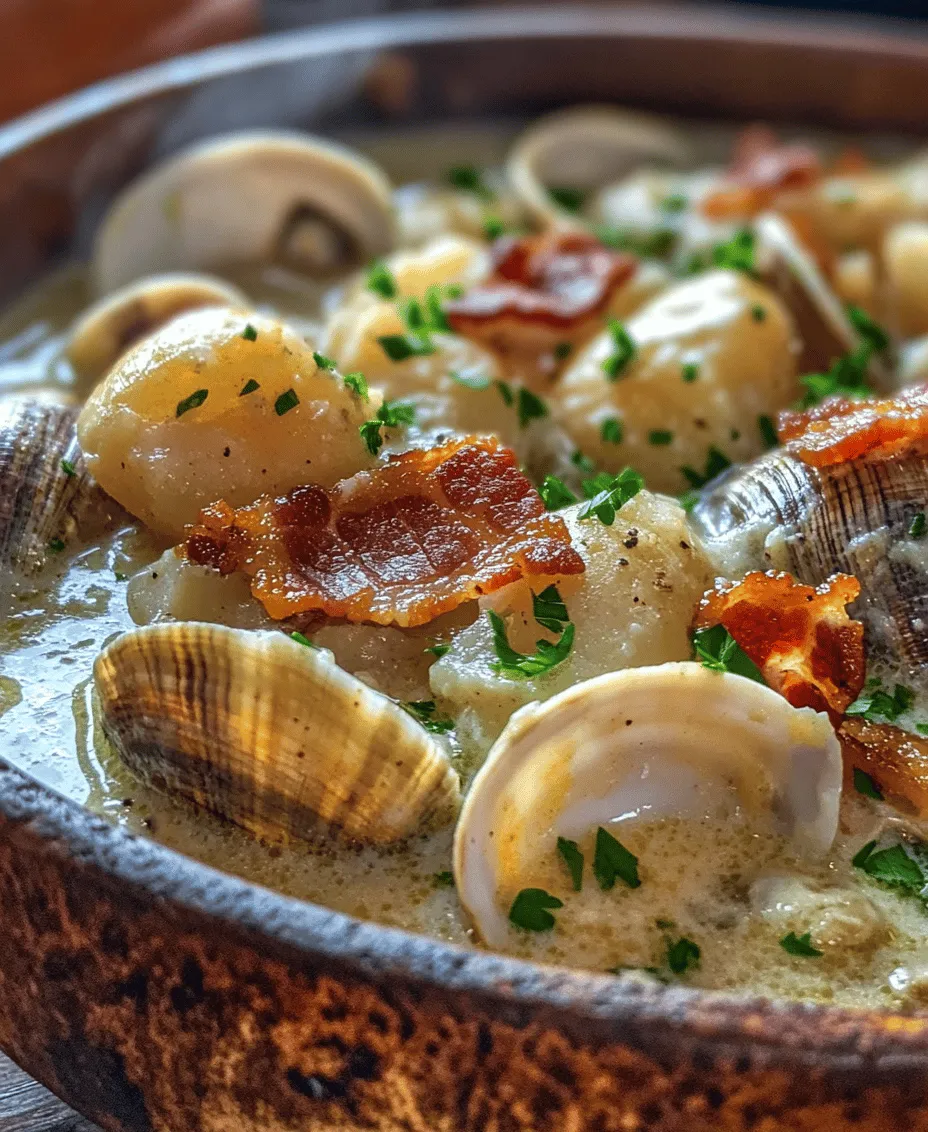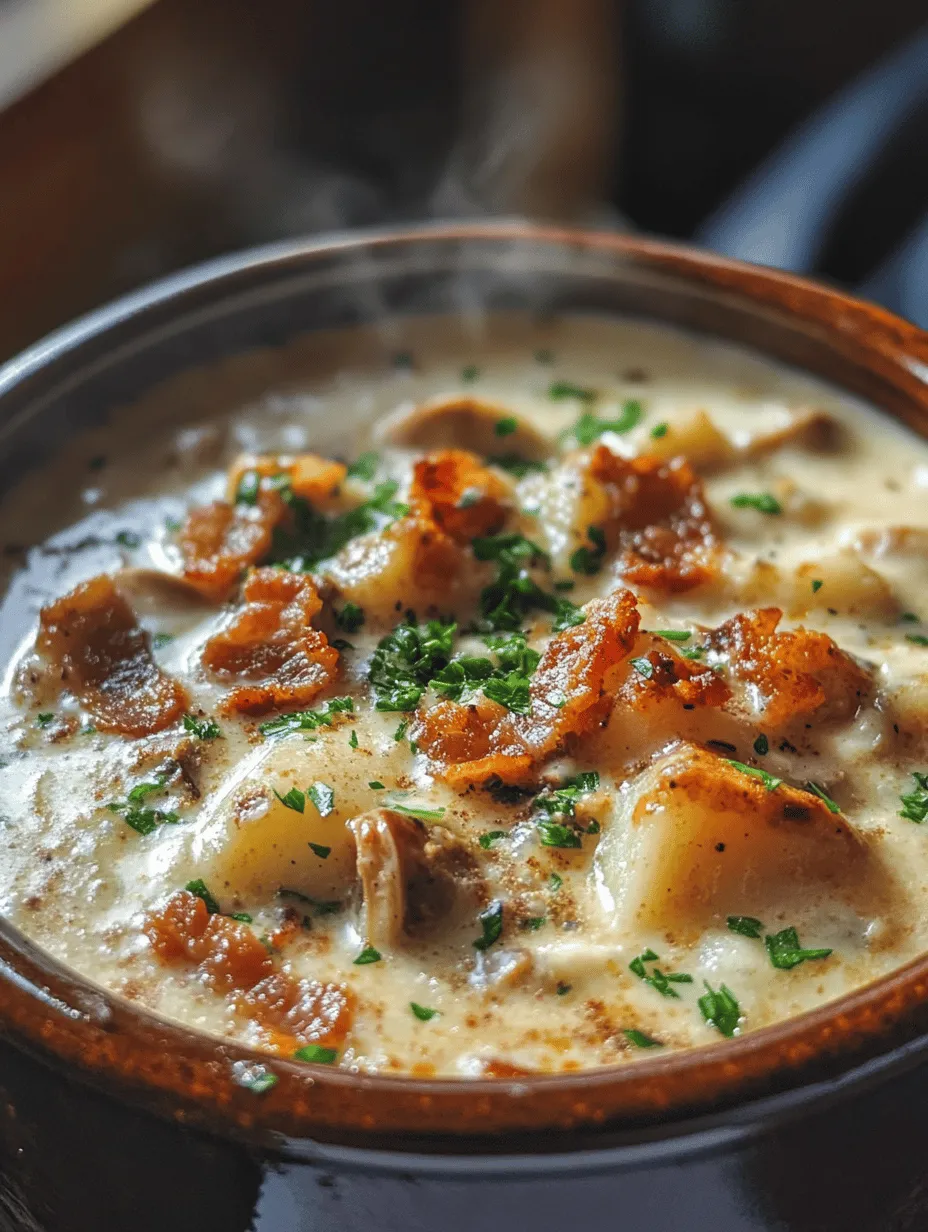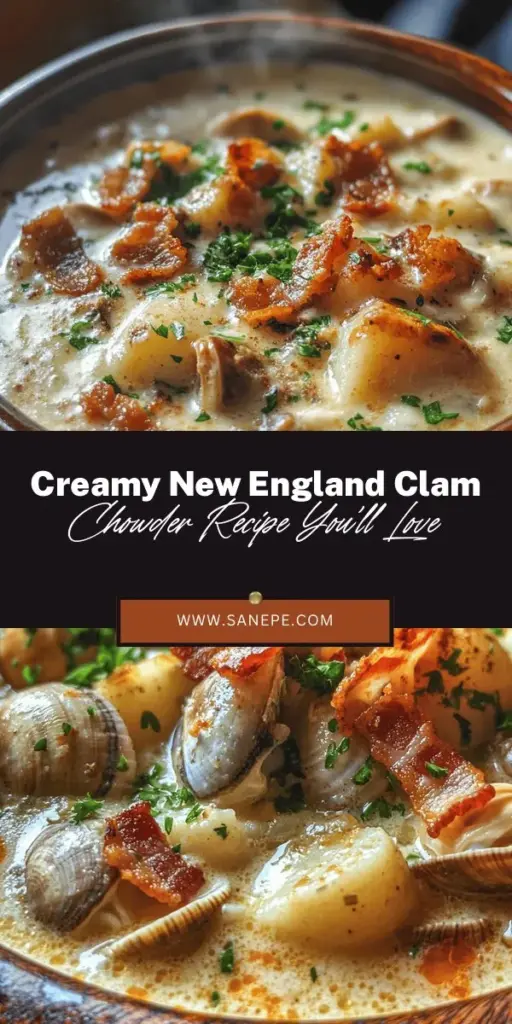Introduction
New England clam chowder is a culinary tradition steeped in the rich maritime history of the Northeastern United States. With its origins tracing back to the early settlers and Native Americans, this dish has become synonymous with New England’s coastal lifestyle and is cherished by locals and visitors alike. The chowder is particularly famous for its creamy texture, which envelops tender clams and hearty vegetables, creating a comforting bowl that warms the soul, especially during chilly New England winters.
The allure of New England clam chowder lies not only in its creamy base but also in the layers of flavor that come together to create a dish that is both satisfying and indulgent. This recipe for Heavenly Creamy New England Clam Chowder stands out due to its perfect balance of ingredients and the richness of its flavors, making it a beloved staple in many households. Whether enjoyed as a cozy dinner or served at a festive gathering, this chowder promises to deliver a taste of New England in every spoonful.
Understanding Clam Chowder
The history of clam chowder is as rich as its flavor. Clam chowder began as a humble dish, likely created by fishermen who would cook up a simple stew using the day’s catch. Over the decades, it evolved into the creamy delight we know today, with recipes varying from region to region. In New England, the chowder is characterized by its thick, creamy base, often made with milk or cream and loaded with potatoes, bacon, and, of course, clams.
A common point of confusion arises between New England clam chowder and its counterpart, Manhattan clam chowder. While both dishes celebrate clams as the star ingredient, they differ significantly in preparation and flavor profile. Manhattan clam chowder features a tomato-based broth, resulting in a tangy and vibrant dish. In contrast, New England clam chowder is known for its luscious, creamy consistency and a more subtle flavor that highlights the natural sweetness of the clams. This difference is a reflection of the cultural influences and local ingredients of each region, adding to the chowder’s fascinating history.
For an authentic New England clam chowder experience, the importance of fresh, high-quality ingredients cannot be overstated. Using fresh clams, locally sourced produce, and premium dairy products elevates the dish, ensuring that each bite is bursting with flavor. This recipe emphasizes the use of such ingredients, allowing you to create a chowder that captures the essence of New England.
Key Ingredients for Heavenly Creamy New England Clam Chowder
Creating the perfect Heavenly Creamy New England Clam Chowder requires careful selection of ingredients. Each component plays a vital role in building the dish’s signature flavor and texture. Here is a detailed breakdown of the key ingredients:
Thick-Cut Bacon
Thick-cut bacon is essential for adding a smoky, savory depth of flavor to the chowder. The rendered fat from the bacon serves as the foundation for sautéing the aromatics, infusing the dish with its rich, meaty essence. When selecting bacon, look for high-quality options that are free of additives for the best taste. Cooking the bacon until it’s crispy not only enhances the flavor but also adds a delightful crunch to the chowder.
Onions, Garlic, and Celery
This trio of aromatics is crucial for building the base flavors of the chowder. Onions add sweetness and depth, while garlic contributes a savory kick. Celery brings a fresh, crisp element that balances the richness of the cream. Together, these ingredients create a fragrant foundation that sets the stage for the rest of the dish. Sautéing them in the bacon fat allows their flavors to meld beautifully, creating a robust base for the chowder.
Potatoes
Potatoes are a staple in New England clam chowder, providing substance and a hearty texture. For the best results, choose waxy potatoes like Yukon Gold or red potatoes, as they hold their shape well during cooking. These varieties lend a creamy consistency without disintegrating completely, ensuring you have tender chunks of potato in every bowl.
Clams and Clam Juice
The clams are, of course, the star of the show in this chowder. Fresh clams, such as quahogs or littlenecks, are ideal for their briny flavor and firm texture. When preparing your clams, ensure they are cleaned thoroughly to remove any sand or grit. Clam juice, often sold in cans or jars, adds additional depth to the chowder, enhancing the seafood flavor. For a truly special chowder, consider using homemade clam broth, which can be made by simmering the shells with water and aromatics.
Heavy Cream
To achieve the signature creamy consistency of New England clam chowder, heavy cream is a must. Its rich texture provides the luxurious body that makes the chowder so comforting. If you prefer a lighter version, half-and-half can be used, but it may result in a less indulgent flavor. Adding the cream at the end of the cooking process allows it to meld perfectly with the other ingredients, creating a velvety finish.
Optional Worcestershire Sauce
For those looking to enhance the umami flavors of the chowder, a splash of Worcestershire sauce can do wonders. This savory condiment adds depth and complexity, complementing the natural sweetness of the clams and the richness of the cream. While optional, it can elevate your chowder from good to extraordinary.
Importance of Quality Ingredients
As with any recipe, the quality of your ingredients directly impacts the final result. For Heavenly Creamy New England Clam Chowder, using fresh, local, and high-quality ingredients ensures that every bowl is bursting with authentic flavor. When you invest in the best ingredients, you’re rewarded with a chowder that embodies the spirit of New England and provides a truly memorable dining experience.
Step-by-Step Cooking Instructions
To create your Heavenly Creamy New England Clam Chowder, you will need a large pot or a Dutch oven, which is perfect for simmering and allows for even heat distribution. Below is a detailed breakdown of each step to guide you through the cooking process:
1. Prepare the Clams: Start by cleaning your fresh clams under cold water. Scrub the shells to remove any dirt or sand. If using canned clams, drain and set aside, reserving the juice.
2. Cook the Bacon: In your large pot or Dutch oven, cook the thick-cut bacon over medium heat until crispy. Remove the bacon from the pot, leaving the rendered fat behind. Chop the cooked bacon into small pieces and set aside for later.
3. Sauté the Aromatics: In the same pot, add diced onions, minced garlic, and chopped celery to the bacon fat. Sauté the mixture over medium heat until the vegetables are softened and fragrant, about 5-7 minutes. Stir occasionally to prevent burning.
4. Add the Potatoes: Once the aromatics are ready, add diced potatoes to the pot. Stir to combine, allowing the potatoes to soak up the flavors from the bacon and vegetables.
5. Incorporate the Clam Juice: Pour in the reserved clam juice along with enough water or homemade clam broth to cover the potatoes. Bring the mixture to a gentle boil, then reduce the heat and let it simmer. Cook until the potatoes are fork-tender, about 10-15 minutes.
6. Add the Clams: Once the potatoes are cooked, stir in the fresh or canned clams. If using fresh clams, allow them to cook just until they open (discard any that remain closed). For canned clams, just heat them through.
7. Finish with Heavy Cream: Lower the heat and gradually add the heavy cream, stirring continuously to combine. Allow the chowder to heat through without boiling to prevent the cream from curdling.
8. Season to Taste: Season the chowder with salt, pepper, and a splash of Worcestershire sauce, if desired. Taste and adjust the seasoning as necessary, ensuring a balanced flavor.
In the next part of this article, we will delve into additional tips for achieving the best results with your clam chowder, as well as answer some common questions to help you master this classic dish. Stay tuned for more insights on perfecting your Heavenly Creamy New England Clam Chowder!

Cooking the Bacon: Achieving Perfect Crispiness
The first step towards a rich and flavorful New England clam chowder is the bacon. Start by selecting quality thick-cut bacon, as it will provide the best flavor and texture.
1. Heat the Pan: Place a large, heavy-bottomed pot or Dutch oven over medium heat. Allow it to warm up before adding the bacon.
2. Cook the Bacon: Add the chopped bacon to the pot, spreading it out evenly. Cook the bacon, stirring occasionally, until it turns golden brown and crispy, about 6-8 minutes. The fat will render out, creating a delicious base for your chowder.
3. Drain Excess Fat: Once the bacon is crispy, use a slotted spoon to remove it from the pot and transfer it onto a paper towel-lined plate to absorb excess grease. Be sure to leave the rendered bacon fat in the pot, as it will enhance the flavor of the vegetables you will add next.
Sautéing Vegetables: Tips for Enhancing Flavors
With the bacon fat still sizzling, it’s time to sauté the vegetables that will form the aromatic foundation of your chowder.
1. Add Onions: Start by adding diced onions to the pot. Sauté the onions in the bacon fat for about 3-4 minutes, or until they become translucent and fragrant.
2. Incorporate Celery and Carrots: Next, add diced celery and carrots. Cooking these vegetables together will allow their natural sweetness to emerge, enhancing the overall flavor of the chowder. Sauté for an additional 5-6 minutes until softened.
3. Introduce Garlic: Finally, add minced garlic and cook for 1 more minute, stirring frequently to avoid burning. Garlic adds depth and richness to the chowder, so don’t skip this step!
Incorporating Potatoes and Seasonings: Timing and Technique
Now that your aromatic base is ready, it’s time to introduce the potatoes and seasonings.
1. Add Potatoes: Pour in diced potatoes—Yukon Gold or Russet potatoes work well due to their creamy texture. Stir the potatoes into the vegetable mix to coat them in the flavorful bacon fat.
2. Seasoning: Sprinkle in salt, black pepper, and a pinch of cayenne pepper for a subtle kick. Stir to combine, allowing the spices to adhere to the potatoes.
3. Add Broth: Pour in seafood stock or chicken broth, ensuring the potatoes are fully submerged. Bring the mixture to a gentle boil, then reduce the heat to low and let it simmer. Cover the pot and cook for about 15 minutes, or until the potatoes are tender but not falling apart.
Adding Clam Juice: Balancing Flavors and Consistency
To take your clam chowder to the next level, the addition of clam juice is essential.
1. Incorporate Clam Juice: After the potatoes are tender, carefully stir in the clam juice. This ingredient adds the quintessential briny flavor associated with clam chowder.
2. Adjust Consistency: If you prefer a thicker chowder, use an immersion blender to blend a small portion of the chowder until smooth, then return it to the pot. Alternatively, mix a tablespoon of cornstarch with a small amount of cold water to create a slurry, and stir it into the chowder to thicken it.
Final Steps: Integrating Clams and Cream for a Velvety Finish
The last steps are where everything comes together for a lush and creamy clam chowder.
1. Add the Clams: Gently fold in the chopped clams (both canned and fresh) to the chowder mixture. If using fresh clams, ensure they are cleaned and shucked before adding them.
2. Incorporate Cream: Pour in heavy cream to achieve that signature creamy texture. Stir the mixture gently, allowing the clams to heat through without becoming rubbery, about 3-5 minutes.
3. Simmer: Allow the chowder to simmer on low heat for a few more minutes, giving the flavors time to meld beautifully.
Adjusting Seasoning: Importance of Tasting Throughout the Cooking Process
Taste your chowder before serving to ensure it’s just right. The seasoning should be balanced, and the chowder should have a rich, savory flavor.
1. Final Tasting: Adjust the seasoning with more salt, pepper, or a splash of lemon juice to brighten the flavors. This step is crucial as the ingredients may vary in intensity.
2. Garnish: When ready to serve, sprinkle the reserved crispy bacon and some fresh chopped parsley on top for a touch of color and added flavor.
Nutritional Information
New England clam chowder is not only delicious but also offers several nutritional benefits.
– Caloric Breakdown: A serving of clam chowder typically contains 300-400 calories, depending on how much cream and bacon are used.
– Nutritional Highlights: Clams are an excellent source of protein, iron, and vitamin B12, while potatoes provide potassium and dietary fiber.
– Balance of Flavors: The combination of creamy, savory, and subtly briny flavors makes this dish satisfying, while the use of fresh vegetables adds vitamins and minerals.
Suggested Serving Sizes and Dietary Considerations
For a well-rounded meal, a standard serving size of clam chowder is about 1 to 1.5 cups. Consider offering it as part of a larger meal, perhaps accompanied by a fresh salad or some crusty bread to soak up the delicious broth.
For those with dietary restrictions, this recipe can easily be adapted. Use coconut milk to create a dairy-free version, or substitute the bacon with smoked paprika for a vegetarian alternative.
Pairing Suggestions for Clam Chowder
To enhance your dining experience, consider these pairing suggestions:
– Complementary Side Dishes: Serve your clam chowder with warm, crusty sourdough bread or a fresh green salad. The bread is perfect for dipping, while the salad adds a refreshing crunch.
– Recommended Beverages: A crisp white wine, such as Sauvignon Blanc, complements the richness of the chowder beautifully. Alternatively, light beers, like a pilsner or a wheat beer, can pair well, providing a refreshing counterpoint.
– Seasonal Variations: In the summer, consider adding fresh corn or diced tomatoes for a seasonal twist. During the fall, a sprinkle of nutmeg or fall spices can bring warmth to the flavors.
Storing and Reheating Clam Chowder
If you’ve made a large batch of clam chowder, knowing how to store and reheat it properly is important to maintain its texture and flavor.
– Best Practices for Storing Leftovers: Allow the chowder to cool to room temperature before transferring it to an airtight container. Store it in the refrigerator for up to 3 days.
– Reheating Tips: To reheat, pour the chowder into a saucepan and heat over low to medium heat, stirring occasionally. Avoid boiling, as this can cause the cream to separate.
– Freezing Considerations: While it’s possible to freeze clam chowder, be aware that the texture may change when thawed. If you choose to freeze it, omit the cream before freezing and add it back in when reheating for the best results.
Conclusion
Heavenly creamy New England clam chowder is more than just a meal; it’s a comforting bowl of nostalgia that evokes memories of coastal New England. The combination of crispy bacon, tender clams, and creamy broth creates a rich and satisfying dish that is perfect for any occasion.
Whether you’re warming up on a chilly evening or hosting friends for a cozy dinner, this recipe is sure to impress. We encourage you to try making this chowder at home and experience the delightful flavors for yourself.
Feel free to share your personal experiences, variations, or cooking tips in the comments below. Happy cooking!


